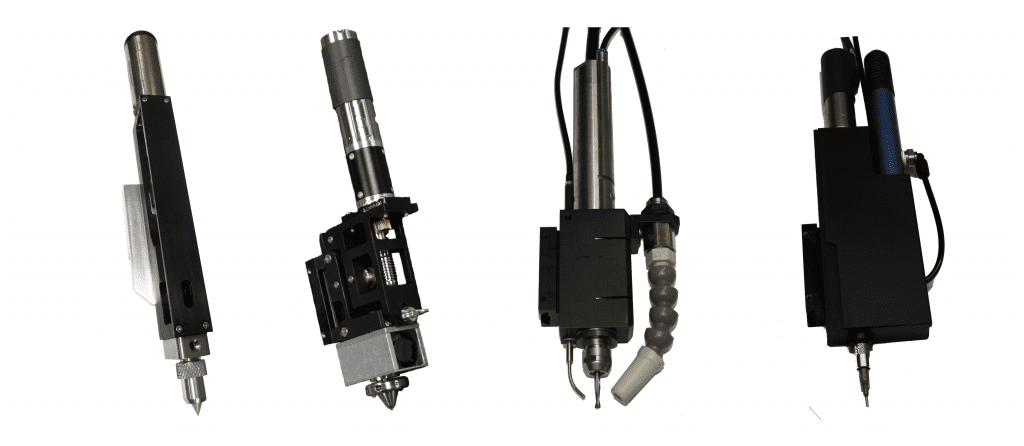[ihc-hide-content ihc_mb_type=”show” ihc_mb_who=”reg” ihc_mb_template=”3″ ]
[vc_row][vc_column][vc_column_text]
“our line of FiTs are fully integrated systems capable of digitally fabricating anything from 2D and 3D printed circuit structures (PCS) to biological structures and can be used almost anywhere on the digital manufacturing floor. Our tools operate in series or parallel on a fast (up to 1 mps), high-precision (up to 10nm resolution, 500nm repeatability, 1 micron accuracy) linear motion gantry.”
The FiT delivered to the Army has 1 full meter of travel in the XY axis at a speed of up to 1 mps (meters per second) and can run 5 tool heads simultaneously, without tool changes. The 1 meter FiT can run nScrypt’s proprietary nFD™ tool head for Material Extrusion, SmartPump™ for Precision Micro-Dispensing, nMill™ for micro-milling, nPnP™360 for pick and place of electronic components and subassemblies, an automated PulseForge 1300 photonic curing system, and a femtosecond laser for cutting or sintering materials. The tool heads are monitored by multiple cameras for automated inspection and computer vision routines. The system also includes a point laser height sensor for Z-tracking and mapping for conformal printing onto objects of any surface shape.
According to nScrypt, the FiT’s SmartPump’s™ Micro-Dispensing tool head eliminates drooling with pico-liter volumetric control and boasts the widest range of materials available for any Micro-Dispensing system: more than 10,000 commercially available materials, ranging from a few centipoise (such as water) to millions of centipoise (much thicker than peanut butter). nScrypt claims the SmartPump’s™ pen tip has the smallest commercially available diameter, 10 microns.
nScrypt claims that the 3Dn-1000’s nFD™ extruder tool head can 3D print the widest range of thermoplastics, composites, and continuous carbon fiber. If a material is not available in a filament format, the FiT’s nFDh™ hopper option loads thermoplastic and composite injection molding pellets.[/vc_column_text][vc_column_text]nScrypt CEO Ken Church said:
“nScrypt is proud to work side by side with the Army to enable the warfighter. nScrypt has now delivered a total of 6 FiT systems to multiple Army bases and labs. This 1 meter tool continues to add fast, precision Direct Digital Manufacturing capabilities inside the DoD.”
Lance Hall from Army RDECOM AMRDEC stated:
“This system provides up to a meter of printing in X and Y directions while maintaining precision; this will touch many DoD products.”
The Army’s machine dimensions are 7’5” (2.28 m) wide by 7’4” (2.25 m) long by 6’9” (2.21 m) tall, weighing in at roughly 12,000 lbs. (6 tons or 5443 Kilos). Much of the weight comes from the base of the gantry, which is a precision ground granite block 8” (20 CM) thick and weighing 5,000 lbs. (2267 Kilos) , which provides a stable foundation for the FiT’s precision manufacturing. [/vc_column_text][vc_single_image image=”5388″ img_size=”full” add_caption=”yes”][vc_column_text]The photo below shows the 3Dn-1000 being hoisted by crane for installation on an upper floor of one of the Redstone Arsenal buildings.[/vc_column_text][vc_single_image image=”5389″ img_size=”full” add_caption=”yes”][vc_column_text]nScrypt offers its FiT in 3 base models (based on size) and multiple configurations: 2 base models for solder, vias, and adhesives, 3 for Direct Digital Manufacturing, and bioprinting configurations. All of the FiT systems use one of two basic hardware configurations: the 3Dn-Tabletop is based on a precision ball screw motion platform and the 3Dn-300, 3Dn-500, and 3Dn-1000 systems are linear gantry systems. The 3Dn-300 has 300 millimeters of travel in the XY axis and the 3Dn-500 has 500 millimeters of travel in the XY axis. All of the tools and configurations share the same vision: a user-friendly and customizable GUI (Graphical User Interface), z-tracking/height sensing, precision motion control, and common software and electronic controllers, which simplify operation, maintenance, servicing, training, and reconfiguration. Lining up two or more systems creates what nScrypt calls its Factory in a Line.
Source: 3dprint.com
The AM Chronicle Editorial Team is a collective of passionate individuals committed to delivering insightful, accurate and engaging stories to additive manufacturing audiences worldwide.



